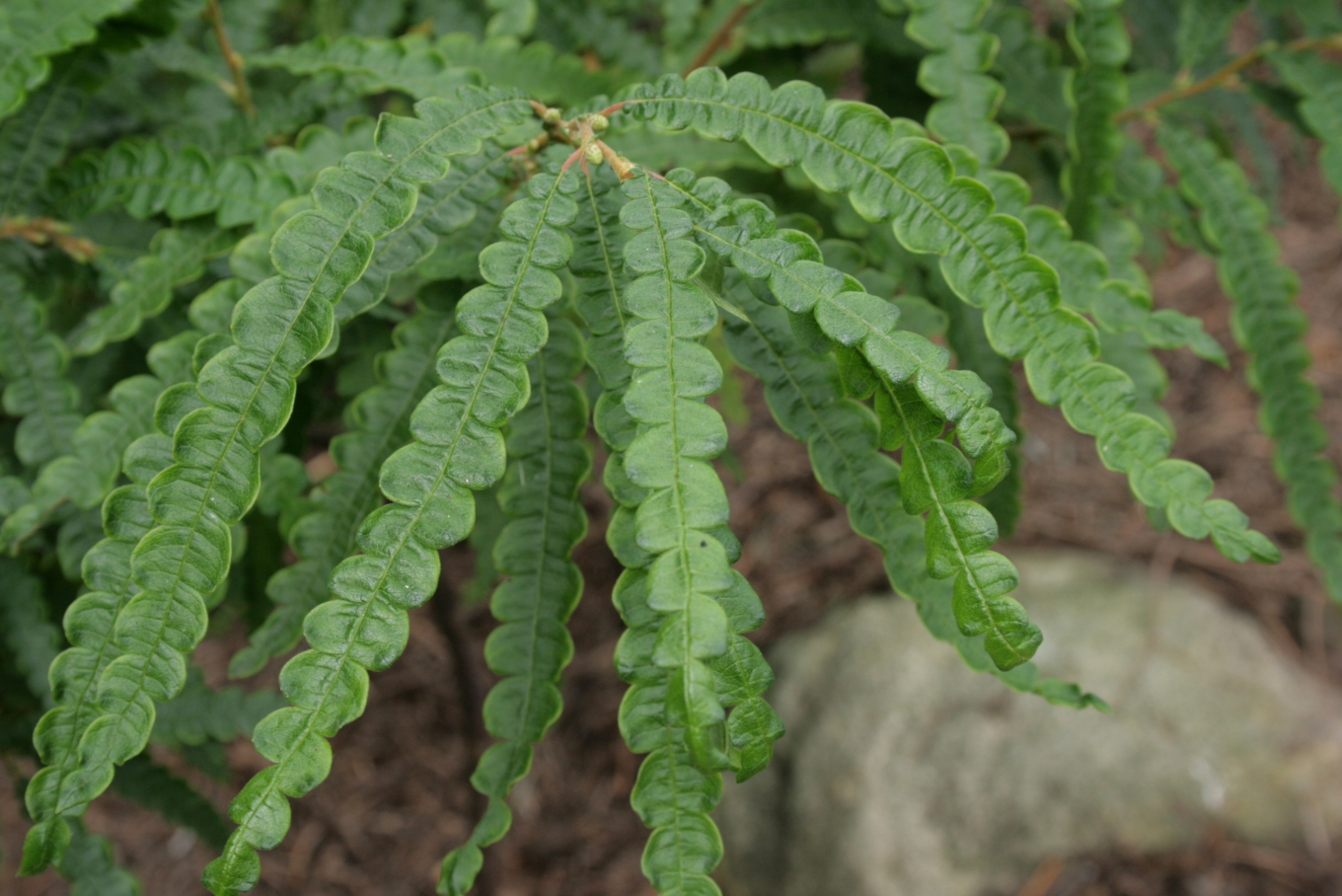Other Names: Sweet-fern, Sweet Fern, Fern Gale, Spleenwort Bush, Sweet Ferry, Meadow Fern.
Description: The name 'Sweetfern' can be a tad bit misleading, since it is actually not a fern but a deciduous shrub. When one sees it, especially when young, it is understandable why it has 'fern' attached to its name; the foliage strongly resembles narrow fern leaves.
Sweetfern grows to about 3 feet high, its trunk is brown with a hint of red and can sometimes be quite hairy. The whole plant can smell very pleasant, especially the leaves when the are rubbed or bruised.
It is native to North America, and can be found growing in the wild from Quebec to the East, Saskatchewan in the West, to about North Carolina in the South. It is in the Myricaceae family, and the Bayberry is a close relative.
Warnings: As with all herbs, one should make sure to be thoroughly informed before ingesting them, and is best to do so under the guidance of a qualified healer.
Cultivating: Sweetfern can be found growing on hillsides, open fields, and in places where pine trees thrive. It does well to hardiness zone 3, and needs to be grown in full sun. It is drought resistant and prefers soil that is sandy, acidic and well-drained. It makes an excellent ground cover on land that has very poor quality soil!
You can buy plants at nurseries, but it maybe a little difficult to find. Another option is to propagate it through root cuttings, instead of seeds {unless you are up for an extreme challenge!}. Once Sweetfern has made itself at home, it needs very little upkeep and will spread very well via its rhizomes. It is a perennial and will mature around its third year.
One disease to be aware of is Sweetfern blister rust, which can also spread to various pines including Jack Pine, Scots Pine, and Ponderosa Pine.
Medicinal/Remedial Properties and Lore: Anti-inflammatory, aromatic, astringent, emollient, haemostat, stimulant, tonic.
Sweetfern has been used by both Natives and settlers to treat various different ailments. One of its most popular uses that is still appreciated today is as a tonic. All parts of the plant would be used, especially the top leaves in a tea to promote overall good health.
A decoction was used internally to treat dysentery, leucorrhea, rheumatism, diarrhoea, and internal bleeding. Henriette's Herbal recommends a dosage of from 1 to 4 fluid ounces, 3 or 4 times a day.
It is apparently quite effective when used topically to sooth Poison Ivy and other irritations, and can be used in this manner to treat rheumatism as well.
European settlers would sometimes use it in folk magic for love talismans and spells, and was sometimes planted in their farm fields in the hopes that some of its hardy properties would brush off on to their own crops.
Other Uses: The nutlets are edible and apparently quite tasty! The leaves can be used to season foods, such as poultry or fish as well. Growing it in the garden is handy as it improves the soil by fixing the nitrogen, and is an excellent plant for wildlife. Deer, birds, and butterfly larvae will feed on Sweetfern, and birds such as grouse and killdeers will nest underneath it.
Sláinte!
Laurel




8 comments:
What an interesting plant! It looks much like a spleenwort fern but seems to have more uses.
I would have to agree with you. I am very pleased that it is abundant in my neck o' the woods. ;)
It's always so empowering to discover a plant like this, that grows locally to you and is as easily as valuable as the well known 'super' plants we've all heard of.
Bek is right! This is a thing that is underrated. =^)
Bek & Permie:
Agreed! :D
This is one of my favorite plants next to mandrake root and lucky hand root
I wish this wasn't so hard to find in my area. When I was a child I used to get severe poison Ivy and nothing helped...until a man who worked with my mom brought her some sweetfern to boil like a tea and slather on my arms...worked like a miracle!!! My hint is that it needs to picked in the fall when it starts turning brownish, then hung to dry out good...I stored mine in large popcorn cans after dried, then just grabbed a handful to boil everytime I needed it. Kept the leaves right in the liquid for potentcy. I always wondered if you could drink it, as it smells SO good while boiling, so i thank you for this article!
Lovely stuff, Comptonia, my family has used Sweetfern for generations much as described but also added to a regular cuppa tea, place a sprig with 6 leaflets or so in your teacup and a teabag on top makes the best combination of flavours you can imagine - if, like me you're a tea drinker. Plants like these make the neighbourhood that much better.
Francis
Post a Comment